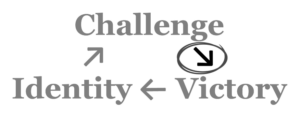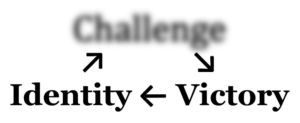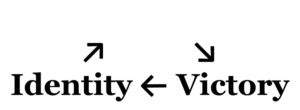We use cookies to ensure that we give you the best experience on our website. By continuing to use this site, you agree to our use of cookies in accordance with our Privacy Policy.
 Login
Login
Your Role
Challenges You Face
results
Learn
Resources
Company
How to make your fundraising ask more effective — according to research, not hearsay


Story review
A story progresses through
- Backstory and setting
These establish motivation from the main character’s original identity. - The inciting incident
This is the main character’s challenge. - Climax and resolution
These show the main character’s victory and altered identity.
Effective fundraising story hinges on the donor’s action – the gift. Thus, the donor is a main character. The donor’s story can progress through these same story steps.
Donor story: Inciting incident
The donor will face a challenge. This challenge is the donation request. In an effective fundraising story, the challenge must connect to a victory.

A compelling ask promises the hope of a compelling victory. A compelling victory is specific and visualizable. This says something about the victory. But it also says something about the challenge. Connecting to a specific victory requires a specific challenge.
Vague or missing challenge
A vague or uncertain challenge is hard to connect to a specific victory. It’s hard to connect to a clear-cut, compelling, visualizable outcome. The fundraising story cycle breaks down. The challenge becomes fuzzy.

Or worse yet, the charity never actually makes the ask. It just does good work. It hopes that people will automatically donate. That story cycle has no challenge.

The inciting incident must be clear and simple
Story requires an inciting incident. The inciting incident presents a challenge. In good story, this challenge is clear and simple.
Consider the highest-grossing movie franchises. In The Matrix, the choice is simple. Take the red pill or the blue pill. In The Hobbit, it’s also simple. Go on an adventure or stay in the shire. In the original Star Wars, the choice is similar. Stay on the farm or go to Alderaan to help the princess.
These challenges aren’t vague. These aren’t challenges to, “Please do whatever you can.” They are simple and specific. They are either yes or no.
The fundraising challenge must be clear and simple
In fundraising story, the simplest challenge is to ask for a specific amount. This is a yes or no question. A specific amount can link to a specific victory. This makes the rest of the story clear and simple.
A specific ask for a specific amount works. But for the fundraiser, it can be scary. What if you guess wrong? What if the amount is too high – or worse, too low?[1] What if the project was the wrong project for this donor? Getting it right requires a lot of information. Sometimes, that just isn’t feasible.
What then? Fortunately, there is another answer. You’ll find it at any restaurant.
Menus can be clear and simple
Suppose you visit a new restaurant. Instead of handing you a menu, the waiter says, “We cook good food. So, just give us some money. Then we’ll go figure out something to cook.”
This would be strange. But it’s a bit like some charities’ approach to fundraising. Their message is, “We do good work. We need money. So, people should give us some. Then we’ll do something good with it.”
This doesn’t work in restaurants. And it doesn’t work in fundraising. It’s a vague request with a vague result.
What can help is a menu. A menu provides simple and specific options. It gives simple and specific prices. This can make the decision easier.
Research: Menus of causes and projects
In research experiments, menus can sometimes help. In one, some people could give to any charity. Others had to choose from a list of only five charities.[2] With only five options, the share of people giving more than doubled.
Menus simplify the choice. They avoid analysis paralysis.[3] But even menus can get too complicated.
One experiment asked people to volunteer at a charity. Increasing the number of charity options from 10 to 30 actually reduced volunteering.[4] Another found that giving increased when people could choose from 8 charities rather than only 3. But increasing from 8 to 16 charities didn’t help.[5]
Another used just one charity: UNICEF. But donors had to pick a project. People had 1, 7, or 13 project options.[6] Giving was lower with just 1 or all 13 options.[7]
Having some options helps. Having too many options hurts.
 hbspt.cta.load(1716178, ‘3dc26462-b900-4083-ac74-92d3d364733b’, {“useNewLoader”:”true”,”region”:”na1″});
hbspt.cta.load(1716178, ‘3dc26462-b900-4083-ac74-92d3d364733b’, {“useNewLoader”:”true”,”region”:”na1″});
Research: Menus of gift amounts
Menus can also help with suggesting a gift amount. One experiment used 120,000 appeal letters for a cancer charity.[8] Some letters included suggested gift amounts. Others didn’t. Those with suggested amounts raised more money.
A menu can also help with another fundraising issue: asking too small. A menu helps by showing other levels. If we’ve guessed wrong on the amount, other options are nearby. Recommending the hamburger? Okay, but the filet mignon is still right next to it on the menu.
Asking for $50,000 to run a program for a year can work. But why not put it on a menu? It can go beside the option of $1 million to permanently endow the program.[9] Listing charitable gift annuity rates is fine. But showing options with lower rates creating bigger donations is smarter.
Even the classic campaign donation pyramid is a menu. Requesting a gift from the pyramid
- Makes a specific ask
- Shows that many others are also giving (and giving even more), and
- Keeps the larger gifts “on the menu.”
Research: Menus with large amounts
One experiment tested the effects of including a larger option.[10] The experiment used 60,000 fundraising appeal letters from a hospital. The standard letter followed the charity’s normal practice. The response card used the three most common gift amounts:
[ ]$10 [ ]$50 [ ]$100 [ ]$___
An alternative version added higher amounts:
[ ]$10 [ ]$50 [ ]$100 [ ]$250 [ ]$500 [ ]$___
The second version raised twice as much money per letter. But another, relatively strange, version worked just as well. This had suggested amounts of only
[ ]$10 [ ]$500 [ ]$___
In both cases, including the higher amount worked better. But this is not the same as increasing all of the options. Increasing the smallest option has a downside. It makes a smaller gift seem unacceptable. This can reduce the share of people who give at all. Experimental results confirm this. One study with 10,000 public TV station members found, “in three independent comparisons, increasing the entire vector of suggested amounts by 20%–40% reduces the probability of giving by approximately 15%.”[11]
Research: Simple works
Menus provide simple options. This makes the decision easier.
One experiment found a way to interfere with this. People prefer to give round numbers. Removing this option frustrates simplicity. Replacing $100 with $95 causes people to avoid this option. A direct mail experiment changed the suggested amounts from,
[ ]$35 [ ]$50 [ ]$75 [ ]$100 [ ]$250 [ ]$___
to
[ ]$35 [ ]$50 [ ]$75 [ ]$95 [ ]$250 [ ]$___
The result? People avoided the unusual option. The researchers explained, “changing one of the suggested amounts in an ask string from $100 to $95 reduces the number of gifts greater than or equal to $90 by more than 30%.”[12]
Menus work because they make the response simple. Of course, requesting one amount is simpler still. One experiment asked for small gifts for nature conservation. This was at the end of a tourist experience.[13] The share of people agreeing to give was:
- 20% with a blank amount
- 35% with three suggested amounts and a blank amount
- 48% with only one amount, using the previous version’s middle suggestion, and
- 55% with only one amount, using the previous version’s lowest suggestion.
The open-ended request was the worst. A menu worked better. A specific amount worked the best. But the specific amount had a trade-off. Asking for more increased the chance for a “no.”
“Tricks and traps,” or delivering value?
It’s fun to learn the tricks that bump up giving responses. It’s fine to focus on making the perfect ask. But the story can’t end at the ask. If it does, donors might still give. But they’ll only do it once.
After all the tricks, the donor experience was either worth the gift or it wasn’t. And if we look at how real donors behave in the real world, mostly it wasn’t. Donors test many charities. Most fail the test. Over 70% of first-time donors to a charity never give to that charity again.[14]
Conclusion
The right environment or framing can help. It can improve the challenge. It can make it more compelling. But if
- Challenge –> /Victory
The challenge doesn’t ultimately lead to a victory, or
- Victory –> /Identity
The victory doesn’t ultimately deliver enhanced identity, then, it’s unlikely to be repeated.
A charity can just take the money. It can deliver nothing to the donor in return. It can then hope the same tricks work the next time. But there is another option. After receiving a gift, a charity can finish the story. The next article looks at this.
Footnotes:
[1] Sometimes, this risk may be softened by a request with a floor. For example, a request could ask for “your best gift ever.” This has a floor of the donor’s previous largest gift. However, phrasing can be tricky here. Asking for a gift of “at least” a certain amount devalues the target amount. It suggests that the amount is a meager, marginally acceptable response. Giving that amount is tolerable but doesn’t fully meet the challenge. This makes the specific request less attractive. Because it uses devaluing language, it can also cause offense to those who feel that their contributions are not being appreciated.
[2] Schulz, J. F., Thiemann, P., & Thöni, C. (2018). Nudging generosity: Choice architecture and cognitive factors in charitable giving. Journal of Behavioral and Experimental Economics, 74, 139-145.
[3] For the classic example of this effect in mutual fund selection, see figure 1 in Botti, S., & Iyengar, S. S. (2006). The dark side of choice: When choice impairs social welfare. Journal of Public Policy & Marketing, 25(1), 24-38.
[4] Carroll, L. S., White, M. P., & Pahl, S. (2011). The impact of excess choice on deferment of decisions to volunteer. Judgment and Decision Making, 6(7), 629-637.
[5] Experiment 1 in Soyer, E., & Hogarth, R. M. (2011). The size and distribution of donations: Effects of number of recipients. Judgment and Decision Making, 6(7), 616-628.
[6] Id at Experiment 2.
[7] However, donations increased when donors could split gifts among multiple projects. In that case both total money and the propensity to donate increased when the number of project options increased from 7 to 13. In this case, donors no longer had to choose the single “best” option but could choose to give something to all the projects they liked.
[8] Baggio, M., & Motterlini, M. (2019). Testing donation menus: On charitable giving for cancer research–evidence from a natural field experiment. Behavioural Public Policy, 1-22.
[9] If your organization is relatively new, consider establishing this fund through a local community foundation to enhance the feeling of permanence and stability.
[10] Ekström, M. (2021). The (un)compromise effect: How suggested alternatives can promote active choice. Journal of Behavioral and Experimental Economics, 90, 101639.
[11] Reiley, D., & Samek, A. (2019). Round giving: A field experiment on suggested donation amounts in public‐television fundraising. Economic Inquiry, 57(2), 876-889.
[12] Id.
[13] Nelson, K. M., Partelow, S., & Schlüter, A. (2019). Nudging tourists to donate for conservation: Experimental evidence on soliciting voluntary contributions for coastal management. Journal of Environmental Management, 237, 30-43.
[14] Levis, B., Miller, B., & Williams, C. (2019, March 5). 2019 fundraising effectiveness survey report. (Reporting 20% retention of new donors in the first 12 months.)
See also, “’Over 70% of people that we recruit into organizations never come back and make another gift, so we’re caught on this treadmill where we have to spend lots of money on acquisition which most nonprofits lose money on anyway, just to stand still.’ Professor Adrian Sargeant” from https://bloomerang.co/retention
Related Resources:
- Donor Story: Epic Fundraising eCourse
- The Fundraising Myth & Science Series, by Dr. Russell James
- 5 Strategies for Turning Smaller Major Gifts into Larger Ones
- At last, the Not-So-Secret Formula for Raising Major Gifts
LIKE THIS BLOG POST? SHARE IT AND/OR LEAVE YOUR COMMENTS BELOW!
Get smarter with the SmartIdeas blog
Subscribe to our blog today and get actionable fundraising ideas delivered straight to your inbox!
